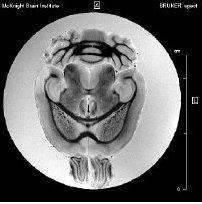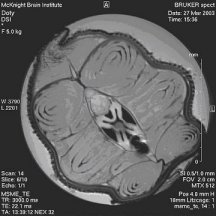Vertical Bore Imaging
 3-Axis Gradient Probes
3-Axis Gradient Probes
NB and WB MRI Probes (with gradients and RF)
Our MRI probes are designed for high-field magnets with 40 to 72 mm inside the RT shims. The MRI probe includes the 26-40 gradient coil and 1H or1H/X, rf Litz coils. The probe permits highest gradients at highest fields.
The MRI probe is normally provided with conventional top “NMR-tube” access.
5 mm to 12 mm Imaging Probes
- Highest S/N
- 350 G/cm at 2.3% duty cycle, water cooled
- Quick, convenient, multi-X tuning
- For magnets up to 900 MHz
- 5, 8, 10, or 12 mm RF Coils
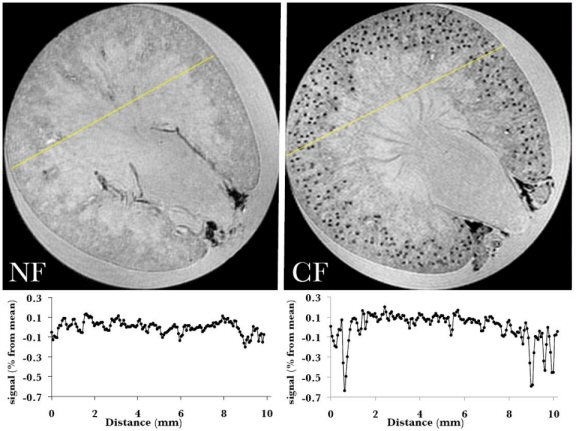
High resolution images from a healthy rat kidney were acquired at 800 MHz, without contrast (NF), and with contrast (CF). The plot below each image shows the percent change in signal intensity (from mean) versus length, along the yellow line. Each spike on the plot under the contrasted kidney represents a single kidney glomerulus (100-150 µm diameter). Images courtesy of Scott Beeman, Dr. Brian Cherry, Dr. Jeff Yarger, and Dr. Kevin Bennett, Arizona State University.
MRI 3-Axis Gradient Coils
Partially assembled three-axis gradient coils
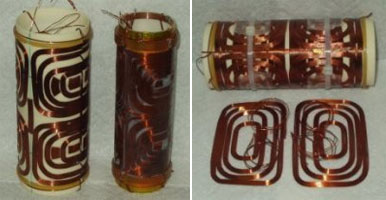
- Active shielding
- B0 eddy current compensation
- Maximum Sample Volume
- Low Noise and Vibration
- High Continuous Gradients
Advances in hardware for magnetic resonance imaging (MRI) are needed to improve image quality, ease of use and functionality in high-field MRI research using small objects. Doty’s MRI gradient coils fill this need.
Low-amplitude B0 eddies are induced in the magnet radiation shields primarily from minute variations in coil diameters along the axis or from axial registration errors between the gradient and shield coils. Our use of alumina ceramic for both the gradient and shield formers allows higher precision to be maintained, and low-amplitude eddy current to be minimal. Ceramic coil forms, together with heavy Golay windings dramatically reduce vibration and noise, even at the highest fields. Any remaining B0 eddy is compensated by a time-dependent correction applied to a B0 shim coil. Another advantage of the alumina coil form is its very high thermal conductivity, which helps equilibrate hot spots. The cooling requirements are then satisfied with relatively minor constraints on the winding geometry.
Higher-order eddies are minimized by active shielding. Our coil designs often achieve a factor of 2 better shielding of the transverse gradients than alternative designs.
There is a strong benefit from gradient coil construction with an alumina ceramic coil form and multilayer windings. We significantly reduce acoustic noise, vibration and recovery time compared to gradient coils from other microscopy MR vendors.
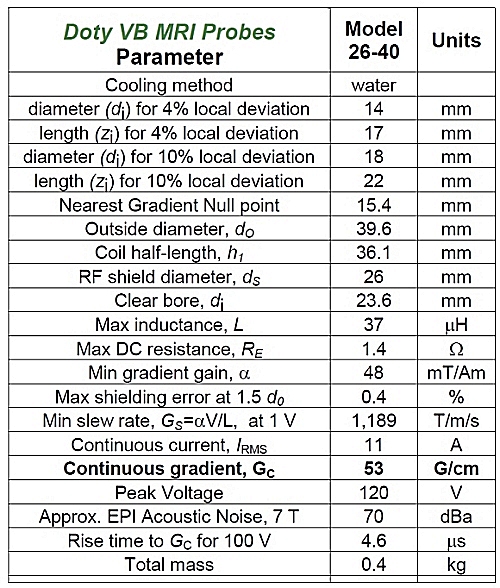
The performance for the X and Y axis are each as indicated in the table above, however, the Z axis is typically better in slew rate, continuous gradient, and volume of linear region than the above table indicates.
Local deviation (or differential linearity) is defined as the rms deviation from the mean gradient over the specified diameter, di, and length, zi, of the cylindrical sample region. The half-length h1 is the distance from the center to the closer of the two external end surfaces. Eddy currents from the internal RF shield are negligible. The gradient slew rate GS is the instantaneous rate of change in gradient when a 1 V step is applied. The continuous current ratings are true continuous ratings for a single axis with no time limit and adequate cooling. Derate the current 30% when all three axis are driven simultaneously.
The RF Coil

Effectiveness of the litzcage coil:
Effectiveness of the litzcage coil can be seen in the 50 micron resolution of the Mouse brain and Baby Atlantic Sharpnose Shark tail below.
Both images were taken using a 21 mm CP Litzcage rf coil at 750 MHz inside a Doty vertical bore imaging probe. Images courtesy of Dan Plant, University of Florida, Brain Institute.

